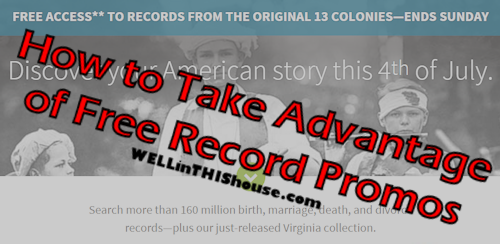Every so often, Ancestry.com will run special promotions where they offer free access to select historical record collections. At the time of this writing, they are currently running the promo for record collections from the Original 13 Colonies for Independence Day weekend, but the advice below will serve as well for any other free access promotion they offer in the future.
This post is most beneficial to Ancestry users with existing accounts and fairly extensive family trees who do not currently have a paid subscription. If you are new to Ancestry, the information won’t be as helpful because it might be easier for you to use the individual search option that Ancestry already provides.

Step 1: Log into your Ancestry account.
This may seem like a no-brainer, but I wasn’t logged in the first time I attempted this.
Step 2: Navigate to the page that lists the free record collections.
Ancestry always sets up a promotional page that lists which collections you can access for free. Until July 5, 2015, the page you’ll want to reach is the 13 Colonies Collections page. The top of the page allows you to search all of the free collections by individual, but this is impractical if you have hundreds or thousands of individuals in your family tree. If you scroll past that, you’ll find a list of included data collections. For Independence Day weekend 2015, it looks something like this:

This particular list of collections is rather extensive, so you can scroll quite far to see what is included. With me so far?
Step 3: Open a new tab for some custom URLs.
This is the part that gets the most tedious, but it’s still easier than searching by individual.
It’s possible to filter all of your available family tree hints by collection. In this case, we want to filter by one or more of the free collections. I like to open Windows Notepad for an easy way to copy/paste my links for each collection. Your links will look something like this:
http://trees.ancestry.com/tree/XXXXXXXX/hints?hf=record&hdbid=YYYY
Replace the bit with the Xs with your own family tree ID number. You can find the information in the address bar of your browser when viewing any part of your family tree. Mine is an 8-digit number starting with a 5. You’ll replace the Ys with the database number for the collection you want to view hints for. To find this number, you’ll want to either hover over the name of the collection you want or open the link to the collection you want in a new tab so you can see what the last 4 or 5 digits of the URL are.
We’ll use the first collection on the list pictured above as an example.
Accomack County, Virginia Births, 1853-65 : http://search.ancestry.com/search/db.aspx?dbid=4331
The database number for this collection is 4331, so you would replace the YYYY in my example link with 4331, like this:
http://trees.ancestry.com/tree/XXXXXXXX/hints?hf=record&hdbid=4331
Since I don’t happen to have any ancestors who were born in Accomack County, Virginia between 1853-65, my results look like this:

But I do have results when I search Massachusetts, Town and Vital Records, 1620-1988:

As you can see, there are hints both new and old waiting for me in this collection. I open each hint in a new tab so I can review them without accidentally closing my hint filter tab.
Step 4: Repeat as necessary.
The tedious part is that you have to repeat the previous step for each collection you would like to search. If you’ve been at your genealogical research for a while, you probably have a sense of which geographic locations are relevant to your family and which are not. I was able to completely skip most counties in Virginia, but I have to be more painstaking when it comes to collections from New York, Connecticut, Pennsylvania, and Massachusetts. I also have Family Tree Maker installed on my computer, so I’ve done some location checks via the Places screen, too.
Step 5: Browse recent hints unfiltered.
As you review hints, you may find that more hints become available from collections you’ve already gone through. It’s far too tedious to keep going back through the collections individually, but at the end of the day, you can just browse your hints as you normally would, unfiltered. You’ll be able to see all of the new hints that became available within the last day.
Of course, these hints may or may not be from the free access collections. There’s a fairly easy way to tell the difference, though:

If the hint is from a free collection, you’ll be able to see all of the details, like David Rowland’s name, birth, and death from the above image. If the hint is not from a free collection, there will be some sort of placeholder for the hidden data, like how it says “date” for George Hull’s Freeman application in the graphic.
Got It?
While the process is still not a simple one, the steps I outlined above seem the most efficient way to make use of free collection access until Ancestry decides to give us the option of filtering hints by free collections. I don’t see that happening, because they don’t want to make it too easy on those of us who aren’t currently giving them money. As such, I hope you found this post helpful!





